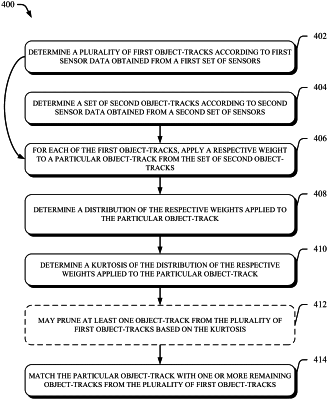| CPC B60W 60/0027 (2020.02) [B60W 30/0956 (2013.01); B60W 50/0205 (2013.01); G01S 13/931 (2013.01); G06T 7/20 (2013.01); B60W 2420/40 (2013.01); B60W 2420/403 (2013.01); B60W 2420/408 (2024.01); B60W 2420/54 (2013.01); B60W 2554/20 (2020.02); B60W 2554/4029 (2020.02); G06T 2207/10028 (2013.01); G06T 2207/10044 (2013.01); G06T 2207/10048 (2013.01); G06T 2207/10132 (2013.01); G06T 2207/30252 (2013.01)] | 20 Claims |

|
1. A method comprising:
receiving, by a processor, a set of vision tracks corresponding to one or more first objects detected by a vision-sensor system on a vehicle;
receiving, by the processor, a set of non-vision tracks corresponding to one or more second objects detected by a non-vision-sensor system on the vehicle;
for each one of the vision tracks in the set of vision tracks, determining whether a first object of the one or more first objects corresponding to the one of the vision tracks matches a second object of the one or more second objects corresponding to any of the non-vision tracks by:
determining possible associations between the one of the vision tracks and each of the set of non-vision tracks;
determining a likelihood of a false detection for each one of the possible associations of a match produced between the one of the vision tracks and the non-vision track for the one of the possible associations;
determining weighting evidence for each one of the possible associations based on a function applied to the likelihood of the false detection determined for the one of the possible associations;
determining a distribution of the weighting evidence for each of the possible associations;
determining a Kurtosis value of the distribution for each one of the possible associations to weight the one of the possible associations among the possible associations; and
selecting, based on the Kurtosis value of each of the possible associations, a high weight subset of the possible associations; and
determining whether the first object corresponding to the one of the vision tracks matches the second object corresponding to any of the set of non-vision tracks by matching the one of the vision tracks to the second object corresponding to the non-vision track of at least one of the possible associations selected for the high weight subset.
|